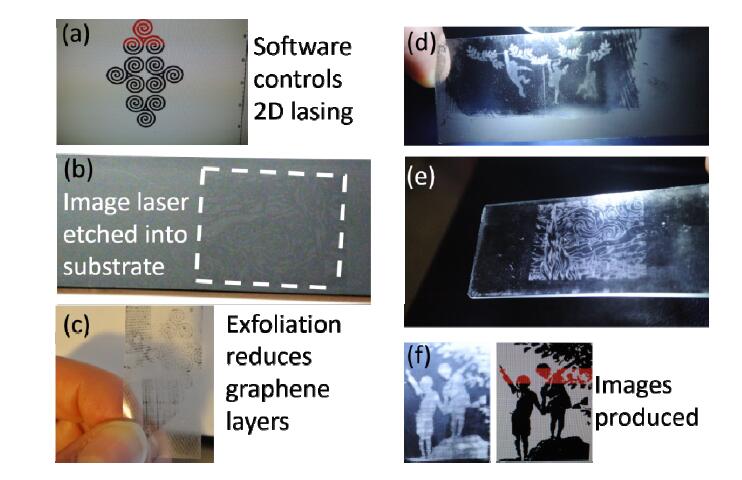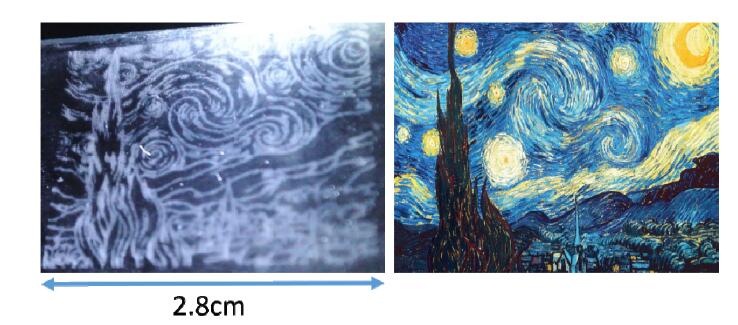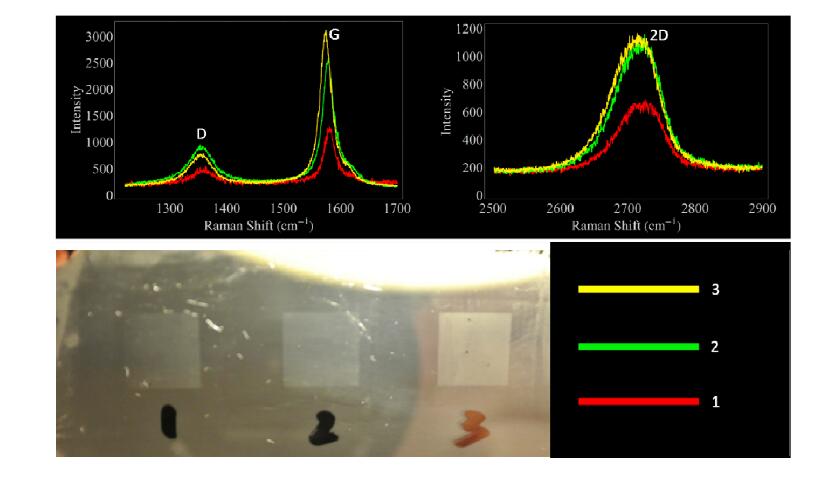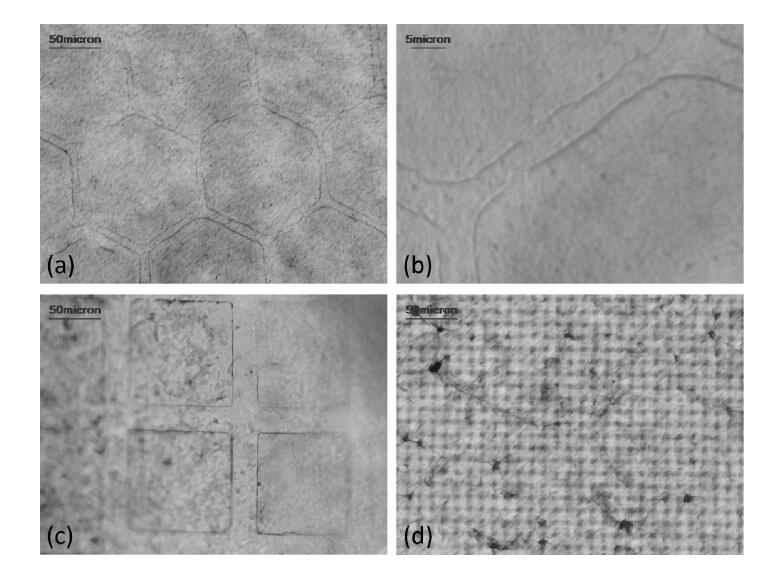1. Introduction
In art, sketches are usually drawn using pencils containing graphite. However, the thoughts of an artist do not usually run parallel with ideas surrounding the fact that this familiar material has become extremely valuable in the technology sector. The primary reason to ignite a spur of intense scientific development was Geim and Noveselov managing to peel graphite down to atomically thin two-dimensional structures (for which they received the Noble Prize in 2010) [1]. They used adhesive tape and multiple peeling steps to exfoliate these layers until single graphite layers were left. The cross-sections of the single layers can be many micrometres. After exfoliation, the material was transferred onto a substrate such as silicon or glass for examination of the number of layers using microscopy. These layers (known as graphene) have incredible electronic, optical and mechanical properties. They are held together by inter-planar van der Waal forces that are much weaker than the in-plane covalent bonding. This allows the layers of graphene to be easily separated. The graphene exhibits a non-linear optical transmission relationship that is a function of the number of layers N, the fine structure constant α≈1/137, and a frequency dependent ratio f(ω) of the optical conductivity of a single layer of graphene to the universal optical conductance (taking values of 0.97-1.05 according to Nair et al. [2] or 1.13 in later work by Zhu et al. [3]). It is important to note that the electronic structures of N layer graphene significantly differ from that including the Dirac cones found for single layers. However, in the visible spectra the layers can be treated as independent to give an opacity of (1-T) ≈ πNα [2]. The number of layers in a system can be found to good accuracy using the relationship for transmission T = (1+f(ω)παN/2)-2. Though atomically thin, a graphene layer can absorb ≈ 2.3% of incident white light [3]. Thus, optical microscopy methods of analysing the transmission of light through graphite can determine the number of layers successfully (see, right hand side transmission plot in Figure 1). It then becomes a question of producing the graphene multilayers, and importantly for future technologies, how to pattern them. Herein, we describe a new advancement that may address a technology gap in the ability to create fine resolution graphene layers that can potentially be controlled to N level precision in combination with photo-spectroscopy techniques. Thin films produced with nanometre/sub-nanometre accuracy are important in photodetectors, sensors, photovoltaics, displays, and optical coatings, as well as in semiconductor/electronic devices.
2. Materials and Method
Graphite in ethanol solution was spray coated onto borosilicate glass to produce a uniform film. The use of ethanol allows a quick drying time at room temperature that leaves behind the graphite sheet. Figure 2 demonstrates the process. After creation of the graphite sample it is placed into a laser etcher. A laser is moved along an x-axis direction, whilst the flat stage that the graphite/glass sample is fixed to moves in the y-direction. The coordinates are controlled by software installed on a desktop computer (Figure 2(a)). The laser has a wavelength of 405 nm and power of 500 mW. Once an image has been produced on the surface of the graphite (e.g., Figure 2(b)), it is not necessary to continue burning down to the glass layer. If this were to be done it would be a long process with this power of laser and would produce a negative image of the desired work. The method used here allows exact reproduction of the image as it is drawn (positive image). An adhesive tape is used to peel the layers of the material from the surface (Figure 2(c)). At this point one could choose to use the exfoliated image on the tape and transfer it to another substrate to search for graphene using microscopy. However, we continue to remove the layers until we have an image on the glass substrate with the optical properties we require for our design. Tilting the glass in an LED beam of white light allows one to clearly see the results (Figure 2(d)-(f)). It is this synergy of art and science that has led to further refinement of the technique.
3. Results and Discussion
One of the most famous artworks in history is “The Starry Night” by Vincent van Gogh. This picture was produced in his typical style using bold, dramatic brush strokes. We created an image in its likeness with the bold lines produced where the laser left its mark in the vertical plane. The result can be seen in Figure 3. “The Starry Night” embodies elements transpiring, or even looking deeper into, the physical world. New methods of “painting” with two dimensional materials, such as graphene, are required to unlock many of their physical mysteries. Lasers and micro/nano-lithography are being developed as the paintbrushes. The reason for choosing to create art with this technique is to demonstrate the capability of the method, before approaching the level of enhancement that is required for graphene electronics [4], photonics [5] or metamaterial [6] design.
Current findings about the size of the flakes left on the substrate after exfoliation indicate that the majority of individual flakes are too small to analyse using the available equipment (Horiba Jobin-Yvon LabRam HR). However, the quality and distribution of the initial graphite was found to be uniform and gave a typical Raman spectra akin to that shown in Figure 4. We are working on increasing the size of the flakes left after exfoliation, but in this initial report, the lasing method is the focus. Indeed, the lasing of “The Starry Night” in graphite took only several minutes to imprint into the layers. The complexity of the curves and turbulent spirals are evidence of the technique being able to handle any geometric reproduction with precision. Furthermore, higher resolution images can be imprinted into the graphite, as is shown in Figure 5, also taking several minutes due to higher resolution required. In Figure 5, one can see square and hexagonal arrays where the etching is produced at the microscale. In Figure 5(a) and 5(b), hexagonal patterns are shown to be imprinted into the layers. The resolution breaks down as the sizes of the geometries become smaller than 10 microns, as can be seen in Figure 5(b) where there are deviations from uniformity of the patterning. In Figure 5(c) for a square array, which has a simpler geometry for linear lasing in the x and y directions, the patterning is smoother. However, in Figure 5(d) the reproduction of smaller square arrays has resulted in the laser producing peaks at the intersections between corners of the squares (dark dots), which give a 3D terrain to the patterning. Nevertheless, we have shown that this method of lasing and exfoliation is a promising technique for the production of microstructures in multilayers of graphene.
In this work a single pass of a laser, controlled to produce a desired image, marked the top layers of graphite but allowed the removal of carbon by exfoliation all the way down to the glass substrate whilst leaving the presence of the image. This implies that the bonding between the layers underneath the pattern has become strengthened. Indeed, recent developments in the analysis of multilayers of graphene have revealed that covalent bonding between carbon atoms from the Nth and (N ± 1)th layers can occur under pressure [7]. The cross-linking between layers to allow this effect requires further examination.
However, the ability to rapidly produce intricate images in layers of two-dimensional materials is shown here and can be refined with the use of industrial standard x-y stages and lasers. It is important to note that the other materials such as N layer boron nitride [8] or other two-dimensional atomic crystals [9] can be engineered using this technique. In order to make graphene multilayers functional, it is not just fundamental understanding of the materials properties that are going to drive it into industry; additionally, controlling these properties and the necessarily complex patterning (against cost) will also be decisive. There are a number of ways of producing graphene layers on a substrate, including chemical vapour deposition, formation of epitaxial graphene, and mechanical exfoliation. These methods are suitable for laboratory research but in order to scale up to industrial levels new methods (or adaptations of current ones) are required. Exfoliation of graphene is typically carried out by repeatedly closing and peeling open the tape upon which the graphite has been removed—leading to a methodical thinning of the graphite until there are isolated few layer graphene flakes. Only then can the graphene layers be transferred for analysis. Also, this repeated peeling and unpeeling can leave a lot of contaminants in the form of residue on the sample that is difficult, if not impossible, to completely remove. In our method the graphite is already on the substrate without accumulation of residue, with the option to not use the graphite removed on the tape. Also, exfoliated graphene layers by a method of continual re-peeling on a tape (“Scotch tape method”) leads to deposition in an unpredictable way. Our technique allows exact control of where the graphene flakes will be on the substrate. The thickness of the graphite can be measured by spectrophotometry [10], optical transmission microscopy techniques [11,12,13,14,15,16], or low power Raman spectroscopy (with accuracy for few layer graphene) [16,17]. Initial examination of areas of similarly produced substrates with larger flakes, by Raman spectroscopy, showed the intensity ratio of the G and 2D bands to be between 0.5 and 2.8, ranging from bilayer graphene to graphite.
Future work will examine the homogeneity of the graphene layers in the images, alternative methods of deposition to produce flakes as large as possible, and use of other layered 2D materials. New techniques of patterning graphene on glass are important for the next generation of solar cells, smart windows and thin film photodevices [16]. Currently indium tin oxide (ITO) is used as “transparent electrodes” in most of existing devices with these applications. However, graphene layers are much more transparent (see Figure 1) with favourable sheet conductance [14] compared to ITO. Coupled to the graphene layers superior electronic properties, if graphene can be patterned effectively then it can supersede conventional materials used in optoelectronics. Finally, it is important to recognise that the technique we describe is not burning graphene layer by layer [18,19,20] but is only laser patterning into the top layers before exfoliation, thus removing the impediment associated with energy cost/cutting times.
4. Conclusions
We have presented for the first time a new method, with the potential for evolution to greater capability, to produce high quality patterns of graphene multilayers on any dielectric substrate. Here we created intricate artwork, juxtaposing science with artistic design. Currently, the speed with which macroscopic images can be made is of the order of minutes. With enhancement of the systems used, increases in the speed of manufacturing complicated shapes in graphite should develop.
Acknowledgements
The authors thank Dr. Olga Kusmartseva, Loughborough University, for assistance with Raman spectroscopy.
Conflict of Interest
The authors have no conflicts of interest.









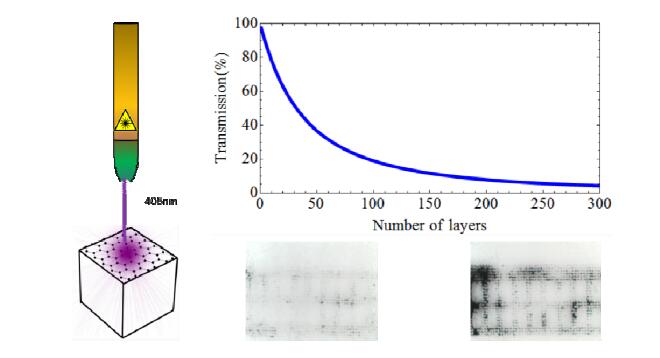
 DownLoad:
DownLoad: 